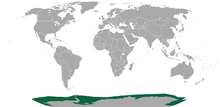
Back فقمة روس Arabic فقمه روس ARZ Spedol (Ommatophoca rossii) AVK Adi ross suitisi AZ روس سۇ ایتی AZB Тюлен на Рос Bulgarian Reunig Ross BR Foca de Ross Catalan Ommatophoca rossii CEB Tuleň Rossův Czech
| Ross seal | |
|---|---|

| |
| Ross seal off Wilkes Land, Antarctica | |
| Scientific classification | |
| Domain: | Eukaryota |
| Kingdom: | Animalia |
| Phylum: | Chordata |
| Class: | Mammalia |
| Order: | Carnivora |
| Clade: | Pinnipedia |
| Family: | Phocidae |
| Genus: | Ommatophoca Gray, 1844 |
| Species: | O. rossii
|
| Binomial name | |
| Ommatophoca rossii (Gray, 1844)
| |

| |
| Ross seal range | |
The Ross seal (Ommatophoca rossii) is a true seal (family Phocidae) with a range confined entirely to the pack ice of Antarctica. It is the only species of the genus Ommatophoca. First described during the Ross expedition in 1841, it is the smallest, least abundant and least well known of the Antarctic pinnipeds. Its distinctive features include disproportionately large eyes, whence its scientific name (Ommato- meaning "eye", and phoca meaning "seal"), and complex, trilling and siren-like vocalizations. Ross seals are brachycephalic as they have a short broad muzzle, and also have shorter fur than any other seal.
- ^ Hückstädt, L. (2015). "Ommatophoca rossii". IUCN Red List of Threatened Species. 2015: e.T15269A45228952. doi:10.2305/IUCN.UK.2015-4.RLTS.T15269A45228952.en. Retrieved 12 November 2021.
